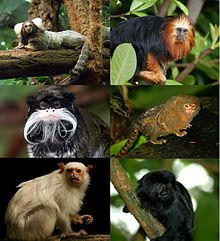Callitrichine
| Callitrichidae | |
|---|---|
 |
|
| Major extant callitrichid genera: Callithrix, Leontopithecus, Saguinus, Cebuella, Mico, Callimico. | |
| Scientific classification | |
| Kingdom: | Animalia |
| Phylum: | Chordata |
| Class: | Mammalia |
| Order: | Primates |
| Suborder: | Haplorhini |
| Infraorder: | Simiiformes |
| Parvorder: | Platyrrhini |
| Family: |
Callitrichidae Gray, 1821 |
| Type genus | |
|
Callithrix |
|
| Genera | |
|
Cebuella |
|
| Synonyms | |
|
|
Cebuella
Callibella
Callithrix
Mico
Leontopithecus
Saguinus
Callimico
The Callitrichidae (also called Arctopitheci or Hapalidae) are a family of New World monkeys, including marmosets, tamarins and lion tamarins. At times, this group of animals has been regarded as a subfamily, called Callitrichinae, of the family Cebidae.
This taxon was traditionally thought to be a primitive lineage, from which all the larger-bodied platyrrhines evolved. However, some works argue that callitrichids are actually a dwarfed lineage.
Ancestral stem-callitrichids likely were "normal-sized" ceboids that were dwarfed through evolutionary time. This may exemplify a rare example of insular dwarfing in a mainland context, with the "islands" being formed by biogeographic barriers during arid climatic periods when forest distribution became patchy, and/or by the extensive river networks in the Amazon Basin.
All callitrichids are arboreal. They are the smallest of the simian primates. They eat insects, fruit, and the sap or gum from trees; occasionally they take small vertebrates. The marmosets rely quite heavily on tree exudates, with some species (e.g. Callithrix jacchus and Cebuella pygmaea) considered obligate exudativores.
...
Wikipedia
